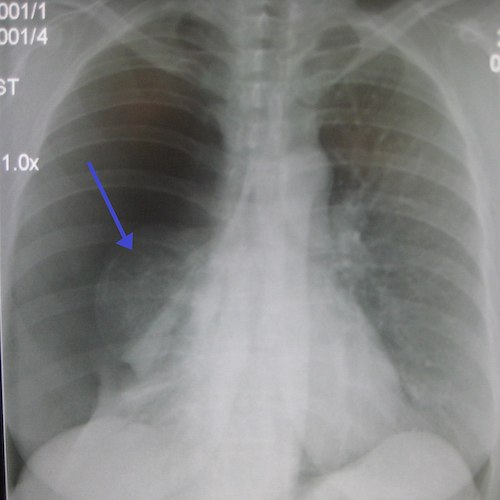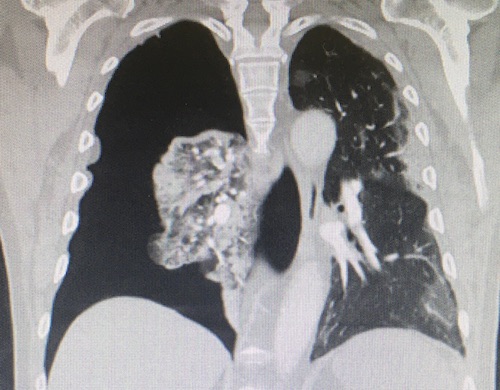Cardiothoracic Surgery: Spontaneous Pneumothorax (PTX)
Spontaneous Pneumothorax
Definition
- Definition: Gas within the Pleural Space without Any External Event
- Types:
- Primary: No Underlying Clinical Lung Disease
- Secondary: From Underlying Clinical Lung Disease
Risk Factors
- Male (3-6x Higher)
- Smoking
- Age:
- Primary – Generally Younger (10-30 Years)
- Secondary – Generally Older (> 55 Years)
- Family History
- Profession (Airline Pilot or Scuba-Diver)
- Marfan Syndrome
- Homocystinuria
- Thoracic Endometriosis
- Malnutrition
- *Classic Patient with Primary Spontaneous Pneumothorax: Healthy, Thin, Tall, Young Male
Association with COVID
- Uncommon Complication
- Incidence of Spontaneous PTX: 0.66%
- Incidence of Cystic Changes in the Lung: 10%
- Predominant Risk Factor: Mechanical Ventilation
- Pathophysiology:
- Cytokine Storm – Hyperactive and Dysregulated Immune Response Causes a Hyperinflammatory form of ARDS
- Thrombosis & Microangiopathy
- Pneumatocele May Be Due to Diffuse Alveolar Damage & Necrosis of Airway Walls
Causes
- Almost All are Due to Rupture of Subpleural Bleb/Bullae
- Cause of Both Primary & Secondary Disease
- Most Common Site: Right Upper Lobe Apex
- *See Cardiothoracic Surgery: Pulmonary Cystic Lesions
- Secondary Associations:
- COPD/Emphysema – Most Common Cause of SSP (50-70%)
- Risk Correlates to Severity of Disease
- Interstitial Lung Disease
- Malignancy
- Tuberculosis (TB)
- Sarcoidosis
- Cystic Fibrosis
- Catamenial Pneumothorax
- Pneumothorax Associated with Menstruation
- Due to Thoracic Endometriosis
- Necrotizing Pneumonia
- COPD/Emphysema – Most Common Cause of SSP (50-70%)
Diagnosis
- Initial Imaging: Chest X-Ray (CXR)
- Size:
- Small: ≤ 3 cm at Apex or ≤ 2 cm at Hilum
- Large: > 3 cm at Apex or > 2 cm at Hilum
Treatment
- Stable:
- Small: Observation with Supplemental Oxygen
- Resolves at 1% Per Day without Treatment
- Supplemental Oxygen: 6 L/Minute for 6 Hours
- Increases Rate of Reabsorption Up to Six-Fold
- Avoid Positive Pressure – Risk for Worsening
- Large: Catheter Aspiration or Chest Tube
- *Some Propose Conservative Management Even for Moderate-Large Size PTX if Asymptomatic (Debated)
- Small: Observation with Supplemental Oxygen
- Unstable: Chest Tube
- Smaller Diameter (≤ 14 Fr) Generally Preferred
- Generally Placed to Water-Seal Initially
- Consider Adding Suction (-10 to -20 cm H2O) if Fails
- Consider Needle Thoracostomy if Chest Tube Placement Will Cause Delay
Complications
- Persistent Air Leak
- Air Leak > 4-5 Days
- Cerfolio Classification:
- Grade 1 (FE): During Forced Expiration Only (Cough)
- Grade 2 (E): Only During Expiration
- Grade 3 (I): Only During Inspiration
- Grade 4 (C): Continuous During Both Inspiration & Expiration
- Treatment: Surgery (VATS Thoracoscopy, Resection & Mechanical Pleurodesis)
- If No Blebs are Seen – Still Preform an Apical Resection
- Recurrent Pneumothorax
- Risk: 50-60%
- Tension Pneumothorax

Pneumothorax on CXR 1

Tension PTX on CT

Pulmonary Blebs; (A) CT, (B) VATS 2
References
- Heilman J. Wikimedia Commons. (License: CC BY-3.0)
- Ozawa Y, Ichimura H, Sakai M. Reexpansion pulmonary edema after surgery for spontaneous pneumothorax in a patient with anorexia nervosa. Ann Med Surg (Lond). 2016 Mar 3;7:20-3.(License: CC BY-NC-ND-4.0)